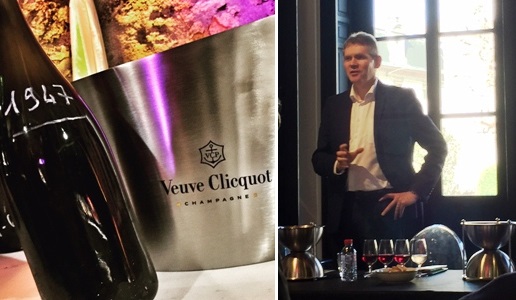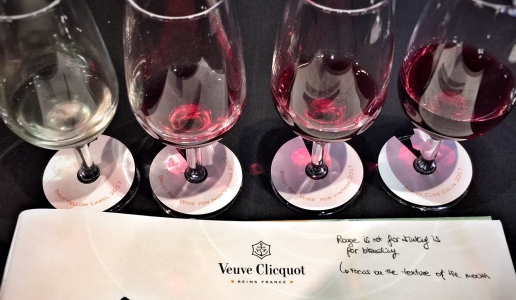Veuve Clicquot, two centuries of rosé blending art

Madame Clicquot invented blended rosé Champagne 200 years ago and to celebrate this bicentennial the Maison organized a unique tasting to explain how a rosé champagne is born.
In a world like that of wine, where everyone holds on to redeeming words like “tradition”, where almost everything seems as if it has already been done and where innovation often means going backwards – like the use of terracotta jars for fermentation – there once was a time when everything was still possible. And yet only a few audacious and extraordinary minds were succeeded in changing this world.
It was in 1818 that Madame Ponsardin Widow Clicquot, a woman in a world of men, revolutionized the production of sparkling wine as it had been known by creating the first blended rosé Champagne and this definitively earned her the title of Grande Dame de la Champagne. At the time, the color of pink Champagne was achieved by mixing in elderberry juice. Madame Clicquot, on the other hand, was convinced that a great Champagne should ever be corrupted with something that was not a grape and so she began to experiment. She was fully aware of what her vineyards and grapes could produce and had a certain affection for the ones she had in Bouzy, where she fell in love with Champagne during her walks there with her husband François Clicquot.
 For some time, the vineyards in that Montagne de Reims village had been producing a top-quality red wine and so she decided to blend some with her still white wines, creating the first blended rosé which was more intense and recognizable than what had been known before. To celebrate the bicentennial of the invention of Rosé d’Assemblage, Maison Clicquot organized a technical tasting led by their Chef de Caves Dominique Demarville, assisted by his team of enologists, with the contribution of Enrico Bernardo, an Italian who has made Paris his home and was the 2004 World’s Best Sommelier. The event was the first time that the Maison revealed how Veuve Clicquot Rosé Champagne was created in all its versions, beginning with the Non-Vintage made with red wines selected for their contribution of fruit and freshness.
For some time, the vineyards in that Montagne de Reims village had been producing a top-quality red wine and so she decided to blend some with her still white wines, creating the first blended rosé which was more intense and recognizable than what had been known before. To celebrate the bicentennial of the invention of Rosé d’Assemblage, Maison Clicquot organized a technical tasting led by their Chef de Caves Dominique Demarville, assisted by his team of enologists, with the contribution of Enrico Bernardo, an Italian who has made Paris his home and was the 2004 World’s Best Sommelier. The event was the first time that the Maison revealed how Veuve Clicquot Rosé Champagne was created in all its versions, beginning with the Non-Vintage made with red wines selected for their contribution of fruit and freshness.
The blind tasting allowed us to appreciate the significant differences of a rosé blend with 12-13 or even 14% red wine and it was surprising to discover how an apparently insignificant 1% difference can modify the proportions and balances of the final Champagne base. The red wines are made in temperature-controlled stainless steel vats that inside have three pistons with a disc for the delicate pressing of the grapes, thus favoring submerged cap fermentation and very soft maceration.
This is the only way to obtain a red wine as elegant as the one from Bouzy that has great personality and tannins that are thick and spicy. This is the red wine used in various percentages, depending in the harvest, in the blend of the Maison’s Vintage Rosé. For the elegant and intense alchemy of their Cuvée de Prestige La Grande Dame Rosé, the chef de cave only uses the Pinot Noir from Clos Colin, a vineyard parcel of just over 1.5h, which has a surprising floral palette and a silky texture that unites boldness and elegance. Nothing is left to chance in this parcel where the grapes for this wine are picked eight days after the Pinot Noir used for the red wine in the Non-Vintage Rosé Champagne.
This is an example of the savoir-faire employed to create the Maison’s great Champagnes that is still inspired by spirit of Madame Clicquot, a woman who was able to bring her Champagnes to the court of Tsar Alexander I thanks to her firm commitment to make a champagne with “only one quality, being the best”.
The greatest surprise of the day was a bottle from the past, an unfindable Vintage Rosé 1947, which confirmed, after 71 years, how well it was made. It was a year when the harvest was reduced to 4,000kg/hectare, with an alcoholic potential of 11.3% and a total acidity of 6.8. The bend of this Vintage was 58% Pinot Noir, 33% Chardonnay and 8% Pinot Meunier of which 14.5% was Bouzy Rouge. It was a heart-moving and intense Champagne in which the notes of iodine dominated over those of candied orange peel and spice that included cardamom and blond tobacco, which were amplified in the mouthfeel by an echo upheld by an acidity that was still present and pure and prolonged by a compelling persistence. This wine was a further, enormous demonstration of the greatness of the Vintage wines produced by a Maison that is too often undervalued by those who do not have the patience to wait.
Related Products
| Product | Producer | Date of publication | Author | Read | |
|---|---|---|---|---|---|

|
Vintage Rosé 2008
Champagne |
Veuve Clicquot | 03/30/18 | Chiara Giovoni |
A blend of 61% Pinot Noir, of which 14% was red wine from the village of Bouzy, 34% Chardonnay and 5% Pinot Meunier. After sitting on the lees for over six years, the wine was given a dosage of 8g/l.... Leggi tutto |
|
|
Veuve Clicquot
|
04/05/16 | Redazione |

 Italiano
Italiano







